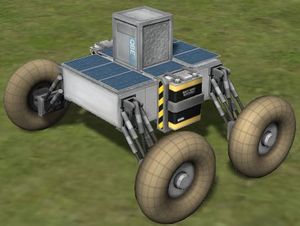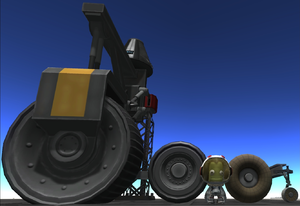Difference between revisions of "Rover"
m (→Basics: !not the plural name;) |
|||
| Line 1: | Line 1: | ||
[[File:Rover.jpg|right|thumb|A simple solar-powered, unmanned rover]] | [[File:Rover.jpg|right|thumb|A simple solar-powered, unmanned rover]] | ||
| − | A '''rover''' is a | + | A '''rover''' is a vehicle equipped with wheels, allowing it to operate on the surface of a celestial body. Rovers can be driven on every body in the system except [[Kerbol]] and [[Jool]]. The parts necessary to construct roveres were introduced with {{version|0.19}}. |
== Constructing rovers == | == Constructing rovers == | ||
Revision as of 20:02, 27 September 2013
A rover is a vehicle equipped with wheels, allowing it to operate on the surface of a celestial body. Rovers can be driven on every body in the system except Kerbol and Jool. The parts necessary to construct roveres were introduced with version 0.19.
Constructing rovers
Basics
For a vehicle to be classified as a rover, it must have at the very least a command module and some wheels. A source of electricity is strongly recommended as no command module has enough internal supply for more than a few minutes of driving. To allow the vehicle to drive straight, the wheels must be mounted parallel to each other in the VAB. While the rover is being driven, the wheels are smart enough to steer in directions matching the control inputs.
Wheels require lots of electricity to operate, so a rover should be equipped with plenty of energy. Batteries can power a rover for a time, but sustainable energy sources in form of solar panels or RTGs are required for a rover to operate indefinitely. Often solar panels are preferred due to their lower mass, but extended solar panels can easily be destroyed by atmospheric drag when on a fast-driving rover in an atmosphere.
| Image | Part | Radial size | Cost ( |
Mass (t) |
Max. Temp. (K) |
Tolerance (m/s) |
Tolerance (g) |
Electricity (⚡/s) |
Max. Motor Speed (m/s) |
Brake Torque (kNm) |
|---|---|---|---|---|---|---|---|---|---|---|
| RoveMax Model S2 | Radial mounted | 300 | 0.05 | 1 200 | 20 | 20 | 1.0 | 12 | 0.34 | |
| RoveMax Model M1 | Radial mounted | 450 | 0.075 | 1 200 | 50 | 50 | 2.5 | 34 | 2 | |
| TR-2L Ruggedized Vehicular Wheel | Radial mounted | 760 | 0.105 | 1 200 | 100 | 80 | 3.5 | 58 | 3 | |
| RoveMax Model XL3 | Radial mounted | 1 200 | 1.25 | 1 200 | 150 | 200 | 5.0 | 15.5 | 30 |
Advanced
To be stable and easy to control, a rover should be relatively wide with a low center of mass. This makes it much harder for the rover to tip over when accelerating, braking, or turning at speed. Rovers become less stable as gravity decreases, so a rover which is perfectly stable driving around the KSC might be easy to flip on Minmus, for example. Another hazard of bodies with low gravity like Minmus is that rovers with a low mass might not exert enough pressure on their wheels to grip the ground and accelerate. One solution to this problem is to use upward-pointing RCS thrusters to push the rover into the surface.
Alternatively, rather than trying to avoid flipping entirely, a rover can be designed to right itself should it survive a inevitable flip. On small rovers, retractable LT-1 Landing Struts can be used to turn them back over when they end up upside down. Larger rovers on low-gravity worlds can help themselves up by using RCS thrusters. Rovers can also turn themselves over with torque from reaction wheels or their command module.
The most complex rovers are practically small spacecraft, using rocket engines to deorbit and land themselves or even return themselves to orbit and carrying multiple kerbonauts or other large payloads.
Piloting rovers
Per default, a rover is controlled with the keys A, D, W and S. Unfortunately these keys also control vehicle rotation, which can make a rover completely uncontrollable on planets with low gravity. As a workaround for this problem, the rover controls can be remapped to different keys in the settings menu. If a number pad is available, a good solution is to map the WASD drive controls to 8456 on the numpad. Another solution is to switch into docking mode when controlling a rover.
Using docking controls, as opposed to staging controls, it is possible to quickly switch which keys control the translation and rotation. When the controls are in "UN" mode the WASD controls rotate the rover, which can be switched with space. When IJKL rotate and WASD translate, which is usually harmless for a rover. With a single click of the space button, pitching can be easily switch between on and off, therefore giving a stable mode of acceleration/direction change and a quick way to adjust the pitch of the rover on low gravity planets, should it be tipped or launched over a hill.
To prevent rovers from driving away when they are dropped, the parking brake (in the top-center HUD, bottom icon on the right) should be applied prior to the drop. While piloting the rover the “B” (default) can activate the brake, but after releasing the button the brakes will release too.
The most flimsy part of a rover are the wheels. When they experience strong impacts, they can get “broken”. In this state they are still intact as a part, but do not work as a wheel anymore. The impact threshold for this to happen is a lot lower than the actual impact tolerance listed in the parts menu. Wheels easily break when the rover jumps, so it is recommended to reduce the speed when the rover is driving over a hill. They can also break when they get faster than the maximum speed of the wheels, which can easily happen when it drives down a slope or uses rocket thrusters to accelerate a rover to higher speeds than it could reach with its wheels only. But it is possible to raise the speed at which the wheels break by reducing the weight pushing on the wheels, for example in atmosphere by using wings.
Fortunately, broken wheels can be fixed by kerbonauts on an EVA. When a kerbonaut is close to the damaged wheel, right-click it and click on "repair". The wheel will immediately be operational again. Usually the wheel jumps a bit which can damage the rover, especially if it is moving or very light.



